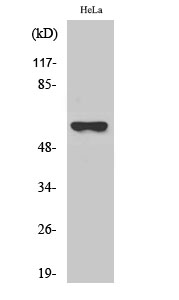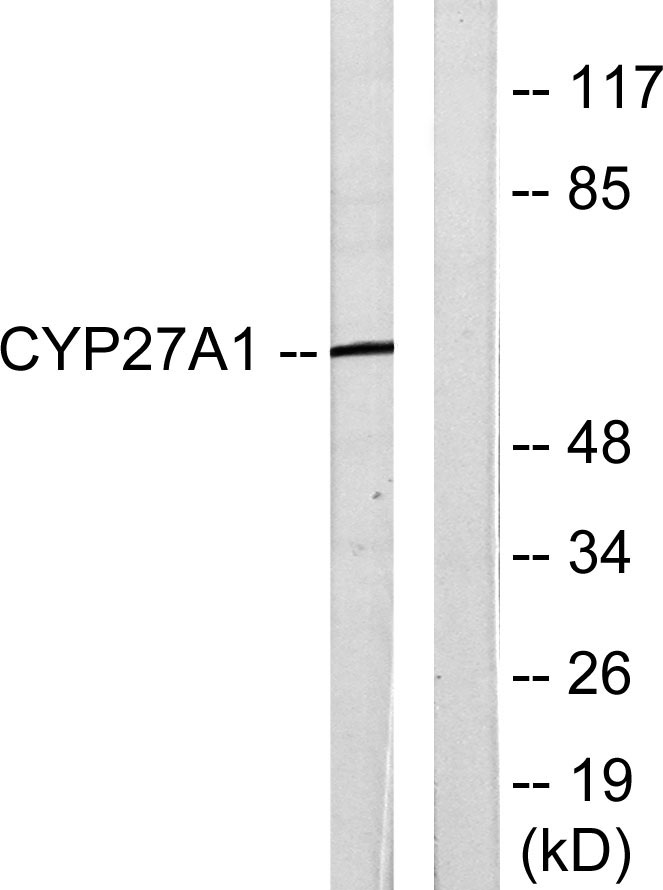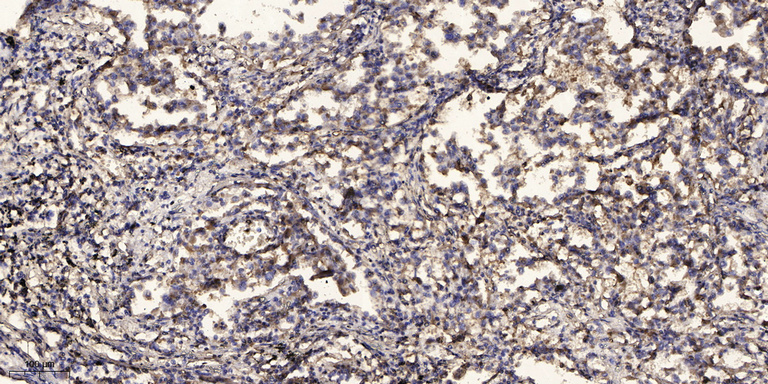CYP27A1 Polyclonal Antibody
- Catalog No.:YT1202
- Applications:WB;IHC;IF;ELISA
- Reactivity:Human;Rat;Mouse;
- Target:
- CYP27A1
- Fields:
- >>Primary bile acid biosynthesis;>>Metabolic pathways;>>PPAR signaling pathway;>>Cholesterol metabolism
- Gene Name:
- CYP27A1
- Protein Name:
- Sterol 26-hydroxylase mitochondrial
- Human Gene Id:
- 1593
- Human Swiss Prot No:
- Q02318
- Mouse Swiss Prot No:
- Q9DBG1
- Immunogen:
- The antiserum was produced against synthesized peptide derived from human Cytochrome P450 27A1. AA range:101-150
- Specificity:
- CYP27A1 Polyclonal Antibody detects endogenous levels of CYP27A1 protein.
- Formulation:
- Liquid in PBS containing 50% glycerol, 0.5% BSA and 0.02% sodium azide.
- Source:
- Polyclonal, Rabbit,IgG
- Dilution:
- WB 1:500 - 1:2000. IHC 1:100 - 1:300. IF 1:200 - 1:1000. ELISA: 1:10000. Not yet tested in other applications.
- Purification:
- The antibody was affinity-purified from rabbit antiserum by affinity-chromatography using epitope-specific immunogen.
- Concentration:
- 1 mg/ml
- Storage Stability:
- -15°C to -25°C/1 year(Do not lower than -25°C)
- Other Name:
- CYP27A1;CYP27;Sterol 26-hydroxylase; mitochondrial;5-beta-cholestane-3-alpha,7-alpha,12-alpha-triol 27-hydroxylase;Cytochrome P-450C27/25;Cytochrome P450 27;Sterol 27-hydroxylase;Vitamin D(3) 25-hydroxylase
- Observed Band(KD):
- 60kD
- Background:
- cytochrome P450 family 27 subfamily A member 1(CYP27A1) Homo sapiens This gene encodes a member of the cytochrome P450 superfamily of enzymes. The cytochrome P450 proteins are monooxygenases which catalyze many reactions involved in drug metabolism and synthesis of cholesterol, steroids and other lipids. This mitochondrial protein oxidizes cholesterol intermediates as part of the bile synthesis pathway. Since the conversion of cholesterol to bile acids is the major route for removing cholesterol from the body, this protein is important for overall cholesterol homeostasis. Mutations in this gene cause cerebrotendinous xanthomatosis, a rare autosomal recessive lipid storage disease. [provided by RefSeq, Jul 2008],
- Function:
- catalytic activity:5-beta-cholestane-3-alpha,7-alpha,12-alpha-triol + NADPH + O(2) = (25R)-5-beta-cholestane-3-alpha,7-alpha,12-alpha,26-tetraol + NADP(+) + H(2)O.,cofactor:Heme group.,disease:Defects in CYP27A1 are the cause of cerebrotendinous xanthomatosis (CTX) [MIM:213700]. CTX is a rare sterol storage disorder characterized clinically by progressive neurologic dysfunction, premature atherosclerosis, and cataracts.,function:Catalyzes the first step in the oxidation of the side chain of sterol intermediates; the 27-hydroxylation of 5-beta-cholestane-3-alpha,7-alpha,12-alpha-triol. Has also a vitamin D3-25-hydroxylase activity.,pathway:Hormone biosynthesis; cholecalciferol biosynthesis.,similarity:Belongs to the cytochrome P450 family.,
- Subcellular Location:
- Mitochondrion inner membrane ; Peripheral membrane protein . Post-translationally targeted to mitochondria. All three of the receptor proteins in the TOM complex, TOMM70, TOMM20 and TOMM22 are required for the translocation across the mitochondrial outer membrane. After translocation into the matrix, associates with the inner membrane as a membrane extrinsic protein. .
- Expression:
- Expressed in the neural retina and underlying retinal pigment epithelium (at protein level) (PubMed:21411718). Expressed in the gray and white matter of cerebellum (at protein level) (PubMed:28190002).
Recruitment of monocytes and epigenetic silencing of intratumoral CYP7B1 primarily contribute to the accumulation of 27-hydroxycholesterol in breast cancer. American Journal of Cancer Research Am J Cancer Res. 2019; 9(10): 2194–2208 WB Human MCF-7 cell, MDA-MB-231 cell, THP-1 cell
Reticulon 3 regulates sphingosine-1-phosphate synthesis in endothelial cells to control blood pressure MedComm Jie-Yuan Jin WB Human 1:1000 human umbilical vein endothelial cells (HUVECs),HEK293 cell
- June 19-2018
- WESTERN IMMUNOBLOTTING PROTOCOL
- June 19-2018
- IMMUNOHISTOCHEMISTRY-PARAFFIN PROTOCOL
- June 19-2018
- IMMUNOFLUORESCENCE PROTOCOL
- September 08-2020
- FLOW-CYTOMEYRT-PROTOCOL
- May 20-2022
- Cell-Based ELISA│解您多样本WB检测之困扰
- July 13-2018
- CELL-BASED-ELISA-PROTOCOL-FOR-ACETYL-PROTEIN
- July 13-2018
- CELL-BASED-ELISA-PROTOCOL-FOR-PHOSPHO-PROTEIN
- July 13-2018
- Antibody-FAQs
- Products Images

- Western Blot analysis of various cells using CYP27A1 Polyclonal Antibody diluted at 1:1000

- Western blot analysis of lysates from HeLa cells, using Cytochrome P450 27A1 Antibody. The lane on the right is blocked with the synthesized peptide.

- Immunohistochemical analysis of paraffin-embedded human Squamous cell carcinoma of lung. 1, Antibody was diluted at 1:200(4° overnight). 2, Tris-EDTA,pH9.0 was used for antigen retrieval. 3,Secondary antibody was diluted at 1:200(room temperature, 45min).



